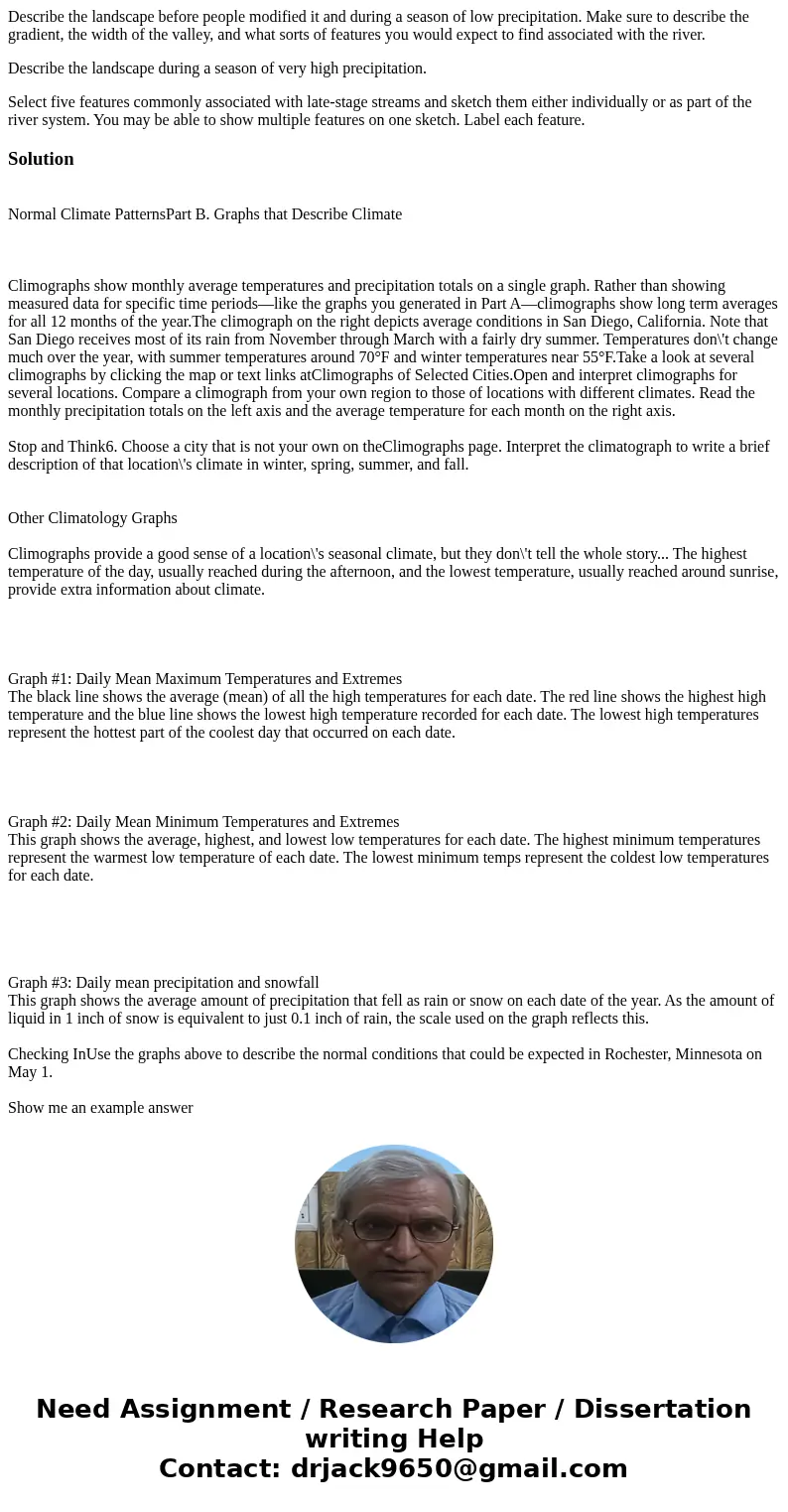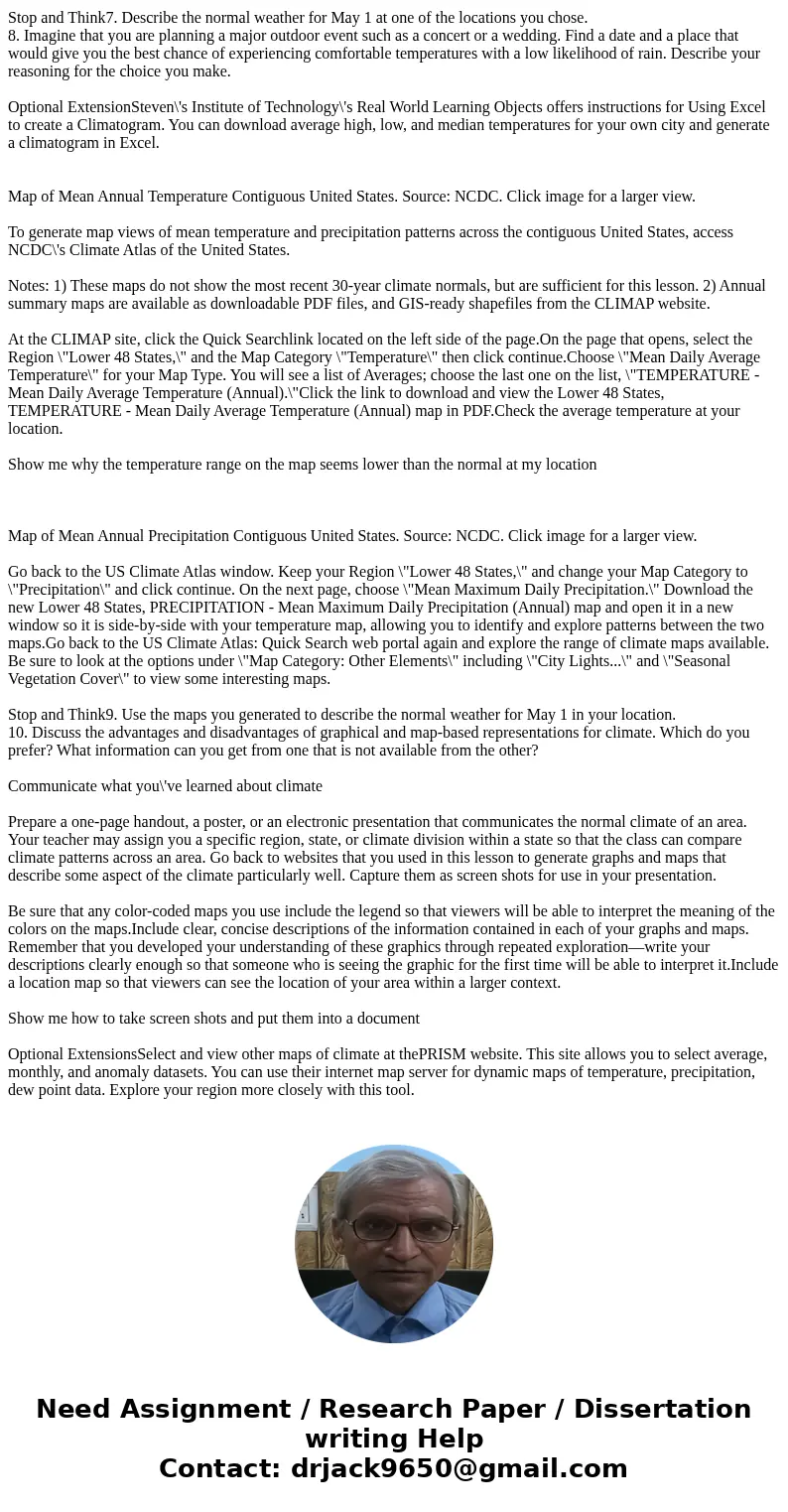Describe the landscape before people modified it and during
Describe the landscape before people modified it and during a season of low precipitation. Make sure to describe the gradient, the width of the valley, and what sorts of features you would expect to find associated with the river.
Describe the landscape during a season of very high precipitation.
Select five features commonly associated with late-stage streams and sketch them either individually or as part of the river system. You may be able to show multiple features on one sketch. Label each feature.
Solution
Normal Climate PatternsPart B. Graphs that Describe Climate
Climographs show monthly average temperatures and precipitation totals on a single graph. Rather than showing measured data for specific time periods—like the graphs you generated in Part A—climographs show long term averages for all 12 months of the year.The climograph on the right depicts average conditions in San Diego, California. Note that San Diego receives most of its rain from November through March with a fairly dry summer. Temperatures don\'t change much over the year, with summer temperatures around 70°F and winter temperatures near 55°F.Take a look at several climographs by clicking the map or text links atClimographs of Selected Cities.Open and interpret climographs for several locations. Compare a climograph from your own region to those of locations with different climates. Read the monthly precipitation totals on the left axis and the average temperature for each month on the right axis.
Stop and Think6. Choose a city that is not your own on theClimographs page. Interpret the climatograph to write a brief description of that location\'s climate in winter, spring, summer, and fall.
Other Climatology Graphs
Climographs provide a good sense of a location\'s seasonal climate, but they don\'t tell the whole story... The highest temperature of the day, usually reached during the afternoon, and the lowest temperature, usually reached around sunrise, provide extra information about climate.
Graph #1: Daily Mean Maximum Temperatures and Extremes
The black line shows the average (mean) of all the high temperatures for each date. The red line shows the highest high temperature and the blue line shows the lowest high temperature recorded for each date. The lowest high temperatures represent the hottest part of the coolest day that occurred on each date.
Graph #2: Daily Mean Minimum Temperatures and Extremes
This graph shows the average, highest, and lowest low temperatures for each date. The highest minimum temperatures represent the warmest low temperature of each date. The lowest minimum temps represent the coldest low temperatures for each date.
Graph #3: Daily mean precipitation and snowfall
This graph shows the average amount of precipitation that fell as rain or snow on each date of the year. As the amount of liquid in 1 inch of snow is equivalent to just 0.1 inch of rain, the scale used on the graph reflects this.
Checking InUse the graphs above to describe the normal conditions that could be expected in Rochester, Minnesota on May 1.
Show me an example answer
To access a similar graph for a city near you, go to the NOAA Earth System Research Laboratory page for U.S. Station Climatologies.Select a state or territory and a city then click Submit. Check out one graph at a time: read the axes and examine the lines to make sense of the information.Use the website to request climatology graphs for three or four different locations across the U.S. Click the links at the bottom of one of the graph pages to access and interpret additional information about each location\'s climate.
Stop and Think7. Describe the normal weather for May 1 at one of the locations you chose.
8. Imagine that you are planning a major outdoor event such as a concert or a wedding. Find a date and a place that would give you the best chance of experiencing comfortable temperatures with a low likelihood of rain. Describe your reasoning for the choice you make.
Optional ExtensionSteven\'s Institute of Technology\'s Real World Learning Objects offers instructions for Using Excel to create a Climatogram. You can download average high, low, and median temperatures for your own city and generate a climatogram in Excel.
Map of Mean Annual Temperature Contiguous United States. Source: NCDC. Click image for a larger view.
To generate map views of mean temperature and precipitation patterns across the contiguous United States, access NCDC\'s Climate Atlas of the United States.
Notes: 1) These maps do not show the most recent 30-year climate normals, but are sufficient for this lesson. 2) Annual summary maps are available as downloadable PDF files, and GIS-ready shapefiles from the CLIMAP website.
At the CLIMAP site, click the Quick Searchlink located on the left side of the page.On the page that opens, select the Region \"Lower 48 States,\" and the Map Category \"Temperature\" then click continue.Choose \"Mean Daily Average Temperature\" for your Map Type. You will see a list of Averages; choose the last one on the list, \"TEMPERATURE - Mean Daily Average Temperature (Annual).\"Click the link to download and view the Lower 48 States, TEMPERATURE - Mean Daily Average Temperature (Annual) map in PDF.Check the average temperature at your location.
Show me why the temperature range on the map seems lower than the normal at my location
Map of Mean Annual Precipitation Contiguous United States. Source: NCDC. Click image for a larger view.
Go back to the US Climate Atlas window. Keep your Region \"Lower 48 States,\" and change your Map Category to \"Precipitation\" and click continue. On the next page, choose \"Mean Maximum Daily Precipitation.\" Download the new Lower 48 States, PRECIPITATION - Mean Maximum Daily Precipitation (Annual) map and open it in a new window so it is side-by-side with your temperature map, allowing you to identify and explore patterns between the two maps.Go back to the US Climate Atlas: Quick Search web portal again and explore the range of climate maps available. Be sure to look at the options under \"Map Category: Other Elements\" including \"City Lights...\" and \"Seasonal Vegetation Cover\" to view some interesting maps.
Stop and Think9. Use the maps you generated to describe the normal weather for May 1 in your location.
10. Discuss the advantages and disadvantages of graphical and map-based representations for climate. Which do you prefer? What information can you get from one that is not available from the other?
Communicate what you\'ve learned about climate
Prepare a one-page handout, a poster, or an electronic presentation that communicates the normal climate of an area. Your teacher may assign you a specific region, state, or climate division within a state so that the class can compare climate patterns across an area. Go back to websites that you used in this lesson to generate graphs and maps that describe some aspect of the climate particularly well. Capture them as screen shots for use in your presentation.
Be sure that any color-coded maps you use include the legend so that viewers will be able to interpret the meaning of the colors on the maps.Include clear, concise descriptions of the information contained in each of your graphs and maps. Remember that you developed your understanding of these graphics through repeated exploration—write your descriptions clearly enough so that someone who is seeing the graphic for the first time will be able to interpret it.Include a location map so that viewers can see the location of your area within a larger context.
Show me how to take screen shots and put them into a document
Optional ExtensionsSelect and view other maps of climate at thePRISM website. This site allows you to select average, monthly, and anomaly datasets. You can use their internet map server for dynamic maps of temperature, precipitation, dew point data. Explore your region more closely with this tool.



 Homework Sourse
Homework Sourse